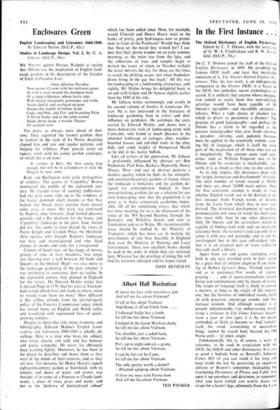EnclOsures Green
Studies in Landscape Design. Vol. 2. By G. A. Jellicoe. (O.U.P., 50s.) MR MALINS quotes Horace Walpole as, saying that Milton was the inspiration of English land- scape gardens in his description of the. Garden of Eden in Paradise Lost:
where delicious Paradise. Now nearer, Crowns with her enclosure green, As with a rural mound the champain head Of a steep wilderness, whose hairie sides With thicket overgrown. grottesque and wilde, Access deni'd; and overhead up grew insuperable highth of loftiest shade, Cedar and Pine. and Firr. and branching Palm A Silvan Scene, and as the ranks ascend Shade above shade. a woodie Theatre Of stateliest view.
The poets, as always, were ahead of their time. They regretted the formal gardens then in fashion in the style of Le Notre, despising clipped box and yew and regular patterns, and longing for wildness. Pope poured scorn on topiary work with his comic garden catalogue, of which this is an item :
St. GEORGE in Box: His Ann scarce long enough, but will be in a Condition to stick the Dragon by next APRIL.
Kent and Burlington were early protagonists of wildness. The genius of 'Capability' Brown dominated the middle of the eighteenth cen- tury. He created vistas of seeming endlessness, had the park come right up to the windows of the house, dammed small streams so that they looked like broad rivers curving from unseen miles away to more. His work was continued by Repton, who, however, liked formal pleasure grounds and a flat platform for the house, and `Capabilityl landscape in the park. Jane Austen did not. She seems to have shared the views of Payne Knight and Uvedale Price, the Hereford- shire squires, who thought Repton's landscape too bare and manufactured and who liked clumps of shrubs and rocks for a foreground.
Clumps of beech trees on the slopes of downs, groups of elms in river meadows, that single tree showing over a wall between All Souls and Queen's in the Oxford 'High'—we owe more to the landscape gardening of the past, whether it was instinctive or conscious, than we realise. In the eighteenth century they planted in England for the future. Mr Edward Malins writes that it pleased Pope in 1736 'that his trees at Twicken- ham would afford fruit and shade to others, when he would want them no more.' How different is this selfless attitude from the get-rich-quick policy of the Forestry Commission today, which has ruined many an English and Welsh valley and woodland with regimented lines of quick- growing conifers.
Despite its thesis-like title, many footnotes and bibliography, Edward Malins's English Land- scaping and Literature 1660-1840 is wholly ab- sorbing. Here is a man who loves his subject, who writes clearly and well, and has humour and poetic sympathy. He wears his obviously deep learning lightly. Moreover, he has been to the places he describes and shows them as they were in the minds of their-creators, and as they are now. For instance, Sir Henry Hoare's superb eighteenth-century garden at Stourhead, with its temples and sheets of water and grotto, was thought of in terms of a Poussin or Claude land- scape, a place of trees, grass and water, and not as the !plethora of. horticultural colour' which has been added since. How, for example, would Flitcroft and Henry Hoare react to the banks of pretty, pale hydrangeas now so promi- nent in front of the Pantheon? Would they think that these set the mood they wished for? I sus- pect that their ghosts wander on an early summer morning, as the mists rise from the lake, and the reflections of trees and temples begin to darken the water, or when, in 'October twilight the water mirrors the sky, for those are the times to watch the drifting swans; not when rhododen- drons bring in the gay bus loads.' All this was the landscaping of a landowning aristocracy, and, rightly, Mr Malins brings his delightful book to an end with Gilpin and Dr Syntax slightly earlier than the 1840 of his title.
Mr Jellicoe writes swimmingly and evenly in his second volume of Studies in Landscape De- sign. He is less interested in the literature of landscape gardening than in artists and their influence on gardeners. He continues the story started by Edward Malins, and shows how a more democratic style of landscaping came with Constable, who found as much pleasure in the informal landscape of cottages, elms, weather- boarded houses and red-tiled roofs in the elmy dells and sandy heights of. Hampstead Heath as he did in his native Suffolk.
Like all writers of his generation, Mr Jellicoe is profoundly influenced by abstract art—Ben Nicholson, Paul Klee, Barbara Hepworth, Henry Moore, Miro—and sees in abstract patterns a dateless quality which he finds in the sixteenth- and seventeenth-century gardens of Japan, where the landscape is miniature and the gardens de- signed for contemplation. Indeed, in these inward-looking gardens, he see a solution for our own landscaping, now that the population is so great as to make aristocratic gardening impos- sible. Of all his stimulating essays, that which has most meaning for us is the discussion of the route of the M4 beyond Reading through the Berkshire and Wiltshire downs and over to Tormanton and so to Wales. His incontrovertible essay should be studied by the Ministry of Transport, which has more say in making the environment of our lives bearable in England than even the Ministry of Housing and Local Government. These two excellent books should be read in the order in which they are reviewed here. Whoever has the privilege of doing this will find his horizons enlarged and his hopes raised.
JOHN BETJEMAN


































 Previous page
Previous page